Chinese Name: 喜洲古镇 Pronunciation: Xǐzhōu Gǔzhèn
Recommended Visiting Time: 1-2 Days
Occupied Area: 5.2 square kilometers
Building Time: During Sui Dynasty (581 - 618 A.D.)
Address: 18 kilometers north of Dali Old Town, Dali Bai Autonomous Prefecture, Dali City, Yunnan Province, China
| Contents | Price |
| Yan’s Compound of Bai Minority in Xizhou | 25 yuan |
| Tour Bus | 45 yuan |
| Contents | Opening Time |
| Yan’s Compound of Bai Minority in Xizhou | 8:30 -18:00 |
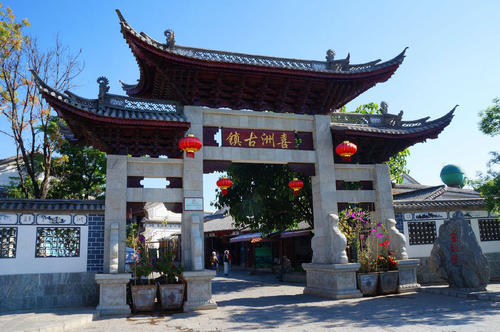
Located 18 kilometers away from the north of Dali Ancient City, Xizhou Ancient Town faces Erhai Lake and lies at the foot of the Cangshan Mountains. Xizhou Ancient Town is one of the main settlements for Bai people with the most numerous and best-preserved Bai citizen building complexes.
Built from the Ming and Qing Dynasties (1368 - 1912) to the founding of the People’s Republic of China, the hundreds of residential houses have a rather unique architectural style with the decorations of various colorful artworks.
Standing far away, visitors will see Xizhou as a whole, just like a museum with sophisticated architectures and elegant elements. Visitors will be much amazed by the talent and creativity of Bai people.
You will see two fertile ficus altissima trees planted at the entrance of the town, which are hardly seen in north China. Its nickname is “Wan Nian Qing” (Evergreen Tree). Bai people believe that this kind of tree symbolizes the prosperity of a town. So, they call it “Fengshuishu” (tree of geomancy). Every town where Bai people live has its “Fengshuishu”.
Xizhou is also one of the famous historical towns and hometowns of overseas Chinese in Yunnan Province with a history of more than 1,000 years. In the Sui Dynasty, it was called Da Li City.
Xizhou is one of the indispensable parts of Dali’s National Scenic Spot, National Nature Reserve, National Historical and Cultural Cities, China’s Excellent Tourist Cities, and China’s Top Ten Charming Cities.
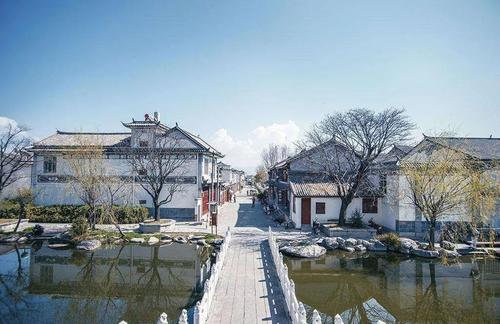
It has distinct national characteristics in culture, architecture, and custom, and develops characteristic ancient villages with tourism resources as the main driving force.
It has some unique advantages. First, with a long history, Xizhou harbors several national, provincial, cultural relic protection units. Second, the unique Bai residential buildings have been designated by the State Council as one of the fifth batch of the national key cultural relic protection units. Third, the costumes, languages, and folk customs represented by the Bai nationality have abundant national customs and historical and cultural flavor.
Above all, with its unique style and profound cultural connotation, Xizhou has attracted historians, travelers, architects, artists, folklorists, economists, sociologists and so on. Xizhou is a microcosm of Bai society. Through this microcosm, we can know more about and understand the Bai’s yesterday and today.
With the rise of tourism, Xizhou has begun to carry out industrial projects focusing on folk tourism of Bai residential houses and folk art since 1992, to publicize Dali and display the traditional and excellent culture of Bai people at home and abroad.
In recent years, Xizhou has formed a traditional ancient village dominated by global tourism by improving the tourism investment environment, standardizing the architectural style of Bai residential houses and strengthening the protection and utilization of ancient villages.
In the Sui Dynasty, General Shi Wansui first incorporated Xizhou.

Located only a few kilometers from the political and military capital of the Nanzhao Kingdom (737 - 902 A.D.), Xizhou was deeply influenced by the Nanzhao Kingdom on architecture and engineering through the formation of the Tea Horse Road (8th-20th century) in 700 A.D. During this period, it was served as a military fortress and a temporary palace for the King of Nanzhao.
During the Ming Dynasty (1368 - 1644), Xizhou thrived in business and trade on the Tea Horse Road.
In the Qing Dynasty (1644 - 1912), the business thrived again. Children of wealthy families generally went abroad for pursuing their studies. So, Xizhou again became a center of academia, gathering professors and intellectuals after Huazhong University relocated here from Wuhan, earning the nickname “Cambridge of the East.”
In 1959, the well-known film “Five Golden Flowers” was shot here.
Upon entering Yan’s Compound in the town, your eyes will fall upon the typical house with its screen wall and two wings. According to the tradition of Bai-style architecture, the screen wall should face east in order to make use of the early morning sun and reflect sunlight into the inner rooms. The screen wall, adorned with elaborate calligraphy and paintings, is considered a talisman, and the Bai people believe it brings good blessings.
Walking inside, you will see the second and then the third yards, and each part is enclosed by four houses with four small rooms built between each of the houses. The final house of Yan’s Compound embraces a modern, western architectural style.
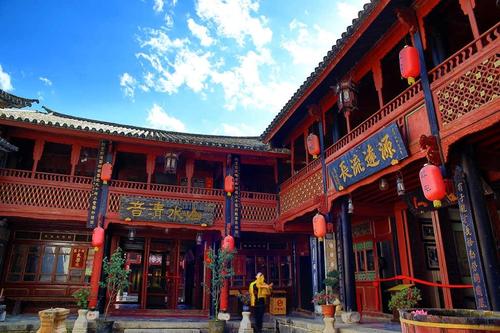
The dwellings of Bai people in Dali, Yunnan Province always make a strong impression on the tourists. Over many years the Bai craftsmen practiced creating traditional Chinese dwellings, as well as cultivating a breathtaking architectural style to call their own.
Located in Xizhou Ancient Town, Yan’s Compound is the most representative and well-preserved Bai-style residential houses.
Yan’s Compound covers an area of about 3,066 square meters, built around the 1920s. It is divided into four parts and each part is cleverly linked together. When visiting this compound, tourists might pay much attention to its screen wall, courtyard layout, overhanging eaves, brackets and murals, which are all representative of Bai’s traditional architecture.
Besides, tourists may have opportunities to watch Bai people’s music and dance performances and taste their local tea (San Dao Cha).
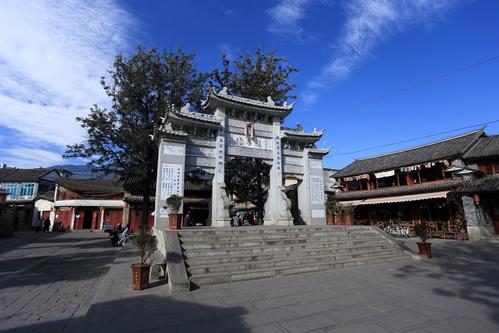
Located at the center of Xizhou Ancient Town, the Square Street (Sifang Jie) is an open area for public gathering with restaurants, food stalls, Xizhou baba (a dough pie served savory or sweet), and a large marble gate named “Ti Ming Fang”, adorned with the names of the past notable Xizhou residents who stood out in the imperial examinations.
Daci Temple, located in Sishang Village, about 250 meters south of Xizhou Ancient Town, Dali City, was also named Lvwa (green glazed tile) Temple because it was built with green glazed tiles in the early years.
According to the history book in the Qing Dynasty (Kangxi Emperor Edition), Daci Temple “built in the Tang Dynasty” was an ancient temple with a history of thousands of years.
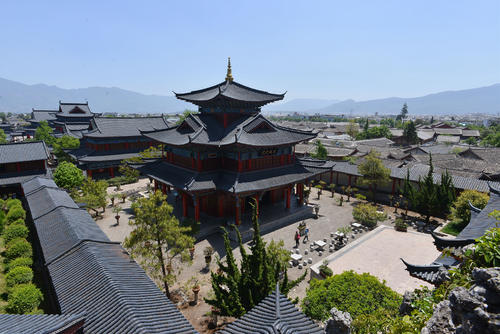
During its heyday, there was a grand building complex covering an area of more than 66,667 square meters, which was the relic of Xizhou when appointed as the capital by Nanzhao King Yi mouxun. It now occupies about 13,333 square meters.
Daci Temple sits from the north to the south, and its layout fully embodies the confluence of Buddhism, Confucianism (the Bai people regard it as a religion), and Taoism.
Dali respected Confucianism very early. Since the Yuan Dynasty began to recruit scholars in Yunnan, talented people in Xizhou had emerged in large numbers.
According to a legend, people built a Confucian Temple. However, it violated the imperial law that restricted towns and villages from setting up Confucian temples. The government sent officials to investigate. Therefore, people hurriedly modified the inside and outside of the temple and the plaques.
What the investigator saw was quite different from the report, and he repeatedly said, “It’s strange”. The people here then changed the name to Qiguan Tang (Wonder Hall) for its similar pronunciation with “qiguai” (strange) in Chinese.
Together with the neighboring Benzhu (local folk religion) temple, the Central Emperor’s Shrine, the area around Daci Temple has become a complete concentration of Bai religious buildings.
Daci Temple was used as the previous site of the Central China Normal University (CCNU). During World War II, to escape from the persecution of Japanese troops, the university relocated to Daci Temple, Xizhou Ancient Town in March 1939, with the invitation of gentlemen in Xizhou.
The temple has statues and icons from different religious beliefs and the Bai people’s Benzhu religion.
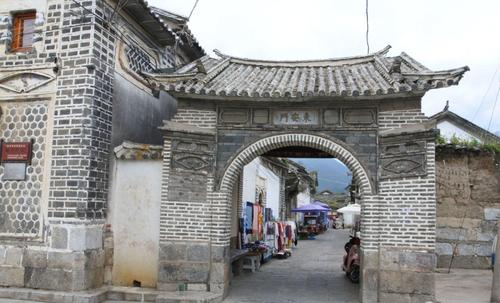
Located at the junction of Dajie Alley and Shiping Street, Xizhou Ancient Town, Dong’an Gate is the east gate of Xizhou. In the past, ancient emperors named the gates in the four different directions of the imperial city as Xi’an Gate (West Peace Gate), Dong’an Gate (East Peace Gate), Bei’an Gate (North Peace Gate) and Tian’an Gate (Heavenly Peace Gate), reflecting the desire of the emperors’ wishes for long-term peace and stability.
Compared with the Zhengyi Gate with an attic, Dong’an Gate is simpler and closer to the style of the gate of a folk house.
The half-moon-shaped doorway is mostly made of blue bricks. There is almost no decoration on the wall, just a few simple frame patterns made of blue bricks protruding outwards.
The lintel is inlaid with a piece of marble about 90 cm long and 30 cm wide. The three characters “Dong An Men” are carved on this ordinary marble.
Dong’an Gate is the entrance of Dajie Alley in Xizhou Ancient Town. With a broad vision, you can directly see the beautiful Erhai Lake to the east. On the west side is the most legendary Dajie Alley in the ancient town.
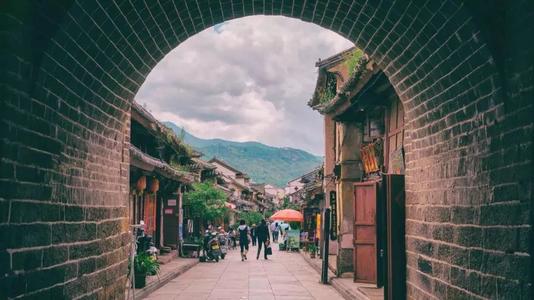
Through this winding alley and the gate at the end of Shiping Street, you can reach the Square Street. Compared with the hustle and bustle of Zhengyi Gate and Square Street, Dong’an Gate is very quiet.
Among the surrounding residential buildings, there are traditional residences for officials, like Martial Mansion; there are also unusual residential houses with a combination of Chinese and Western styles, such as Yang Guixian’s Residence. There are also handicraft family workshops carrying forward embroidery, wood carvings and other cultural heritage, like “Happy Embroidery Workshop” (Xi Xiu Fang) and “Tiangong Workshop” (Tian Gong Fang).
Here, in addition to taking photos under the quaint gate, you can also see the fine folk houses that perfectly combine the architectural traditions of Bai folk houses with European architectural styles, and you can enjoy the fine folk arts, such as the exquisite traditional embroidery and handmade wood carvings of Bai nationality.
There are long stone chairs on both sides of Dong’an Gate for people to rest and chat. It is an important place for outdoor activities and communication among residents of Dajie Alley. Every afternoon, the elderly living in the vicinity of Dajie Alley and Shiping Street will come here and sit quietly for a whole afternoon, as if they are performing a ritual in life.
When you come to Dong’an Gate, the simple gate tower, quiet old houses, exquisite handcrafts, beautiful countryside and quiet old people will slow you down and your heart will calm down as well.
The famous writer Laoshe mentioned Xizhou Ancient Town in one of his books. The following paragraphs were taken from his book Dian Xing Duan Ji (a short record of traveling in Yunnan).
“Xizhou Ancient Town is a miracle. I cannot imagine a graceful town exists in the wild part of China.”
As soon as entering the town, I almost feel like arriving Cambridge in the United Kingdom. The flowing water meanders nearby streets, so citizens could wash vegetables and do laundry as they walk out of the home, and the dirtiness could be washed off.
Less than one mile away is Erhai Lake; less than five or six miles away are the mountains. A town between lake and mountains like this is like a paradise.”
1. There is no admission ticket charge in Xizhou Ancient Town.
2. Some traditional festivals and pageants are held by Bai people between March and April every year. You could enjoy ethnic customs more deeply than any other time.
Take the tour bus at the Tour Bus Service Center Yan’s Compound Square Street Dong’an Gate take the bus and go back to the Tour Bus Service Center
A taxi will be more convenient from Dali or Kunming to the ancient town.
Chinese: 请带我去喜洲古镇。English: Please take me to Xizhou Ancient Town.
If you go to Xizhou Ancient Town from Dali Old Town (Dali Gucheng), it takes about 30 minutes (about 50 yuan).
If you go to Xizhou Ancient Town from Dali Huangcaoba Airport, it takes about 1 hour and 10minutes (about 130 yuan).
If you go to Xizhou Ancient Town from Dali Railway Station, it takes about 1 hour and 10 minutes (about 100 yuan).
